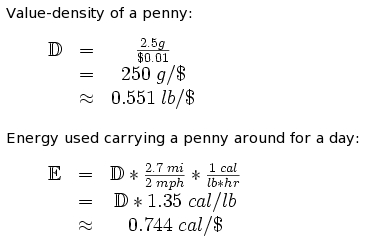Nomad refuses to carry coinage. I recall one time (likely apocryphal) he purchased a soda for $1.25 at a train station, and then put his change (all seventy-five cents) on top of a garbage can and left it. I can’t remember if I did the sterotypical thing and picked it up, but I’m sure I called it foolish.
But it got me thinking; is carrying change a waste of energy? If you carried a pocket-full of coins all day, could you purchase more calories of food than you burned carrying it? I thought about it for a while, and I couldn’t reason it out, so I decided to calculate it. The answer somewhat surprised me.
Coins are quite light. The U.S. Mint says that a penny weighs 2.5 grams, a nickel 5g, a dime 2.268g, and a quarter 5.67g. Figuring out how much walking “all day” is was difficult. I got numbers (for an average American adult) that varied from a quarter-mile to five miles. I decided to go with a middle-ground number, 2.7 miles. Looking at some numbers for calorie consumption during walking, I estimated that a person burns one calorie per pound of weight per hour of walking at 2mph. Once I had all of my data, the calculations were pretty easy.
Essentially what that means is that if you carried a whole dollar of pennies around for a day, you would burn almost three-quarters of an additional calorie. Even the least calorie-dense foods (like, say, Pepsi One) are enough to make it worth it, and some of the most calorie-dense foods (like the Big Mac) provide you with several hundred calories per dollar.
(Pennies require the most energy-per-dollar to carry. A nickel would cost 0.297 calories per dollar, and dimes and quarters both run a measly 0.068.)
